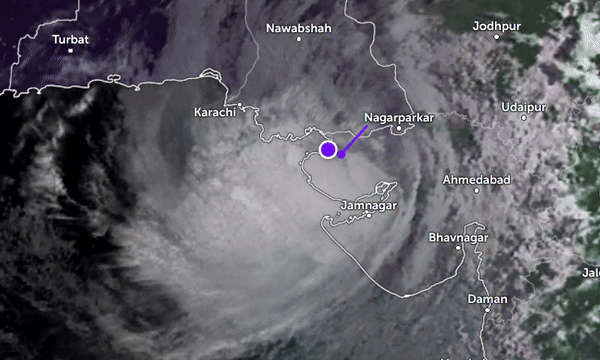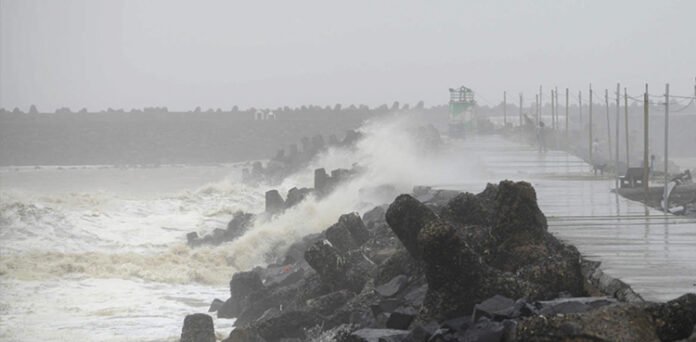Understanding the Cyclone Threat to Sindh: A Detailed Exploration
The potential for a cyclone to impact the Sindh coastline is a matter of increasing importance, especially in light of recent climatic changes and seasonal conditions. Cyclones, also known as tropical storms, are intense low-pressure systems characterized by strong winds, heavy rain, and storm surges. When these systems form in the Arabian Sea, they pose a significant risk to coastal areas, including the province of Sindh in Pakistan.
1. Current Climatic Conditions in the Arabian Sea
The Arabian Sea has shown heightened activity in recent times, largely due to rising sea surface temperatures. These temperatures are a critical factor in cyclone formation. When the sea surface temperature exceeds 26.5°C, it provides the necessary heat and moisture to fuel a cyclone. This year, temperatures in the Arabian Sea have been notably higher, creating an environment ripe for cyclone development.

Another crucial factor is the atmospheric conditions over the Arabian Sea. Low wind shear (the change in wind speed and direction with height) is particularly important. Low wind shear allows a cyclone to develop vertically without being torn apart, increasing the chances of it becoming a powerful storm. Additionally, high humidity levels in the mid to upper atmosphere provide further energy to these systems, aiding in their growth and sustenance.
2. Cyclogenesis and Trajectory Concerns
Cyclogenesis, or the birth of a cyclone, begins with a disturbance in the atmosphere, such as a low-pressure area or a tropical wave. When these disturbances encounter favorable conditions, they can start to organize into a cyclonic system. In the current scenario, meteorological agencies have been tracking such disturbances in the Arabian Sea, which have the potential to develop into a cyclone.

The trajectory of a cyclone is influenced by various factors, including the prevailing winds, the Coriolis effect (caused by the Earth’s rotation), and existing weather patterns. Historically, cyclones that form in the Arabian Sea can take different paths. Some move westward towards the Arabian Peninsula, while others can curve northwards, potentially threatening the Sindh coastline.
3. Historical Context: Cyclones That Hit Sindh
Sindh has faced cyclones in the past, each bringing devastation in its wake. Notable examples include:
- The 1999 Pakistan Cyclone: One of the deadliest cyclones in the region’s history, this storm caused widespread destruction in Sindh, particularly in Karachi, with over 6,000 lives lost.
- Cyclone Phet (2010): Although it weakened before making landfall, Phet still caused significant damage due to heavy rains and flooding in coastal Sindh.
- Cyclone Nilofar (2014): Predicted to be a severe storm, Nilofar eventually weakened, but it highlighted the potential threat and the importance of preparedness.
These historical events underscore the need for constant vigilance, especially during the cyclone season.
4. Potential Impacts on Sindh’s Coastline
If a cyclone were to strike the Sindh coast, the impact could be severe:
- Storm Surges: A cyclone can cause sea levels to rise rapidly, leading to storm surges. These surges can inundate coastal areas, damaging infrastructure, homes, and agricultural lands.
- Heavy Rainfall and Flooding: Cyclones are often accompanied by torrential rains, which can lead to flash floods, especially in low-lying areas. This can disrupt transportation, cause landslides, and contaminate water supplies.
- High Winds: Cyclones bring with them powerful winds that can uproot trees, damage buildings, and disrupt power and communication lines. For coastal Sindh, this can lead to prolonged outages and isolation.
- Marine Hazards: The fishing community is particularly vulnerable during a cyclone. Rough sea conditions can lead to the loss of boats and lives. Fishermen need to be alerted well in advance to avoid going out to sea during such times.
5. Preparedness and Community Response
Given the current conditions, it’s crucial for local authorities and communities to be prepared. This includes:
- Monitoring Weather Updates: The Pakistan Meteorological Department (PMD) provides regular updates on weather conditions and potential cyclones. Staying informed is the first line of defense.
- Emergency Preparedness Plans: Local governments should have clear evacuation plans in place, including identified safe zones and shelters for people to move to in case of an emergency.
- Public Awareness Campaigns: Educating the public about the dangers of cyclones and how to respond can save lives. This includes knowing how to secure homes, stock up on essentials, and respond to evacuation orders.
- Strengthening Infrastructure: Building cyclone-resistant structures and reinforcing existing ones can reduce damage and loss during a storm.
6. Conclusion: Navigating the Uncertainty
While it’s impossible to predict with absolute certainty if or when a cyclone will hit the Sindh coastline, the current climatic conditions in the Arabian Sea suggest that the risk is present. Being proactive in monitoring, preparing, and responding to these natural events is essential. As climate change continues to influence weather patterns, the importance of understanding and preparing for cyclones becomes even more critical for the safety and resilience of Sindh’s coastal communities.
No responses yet